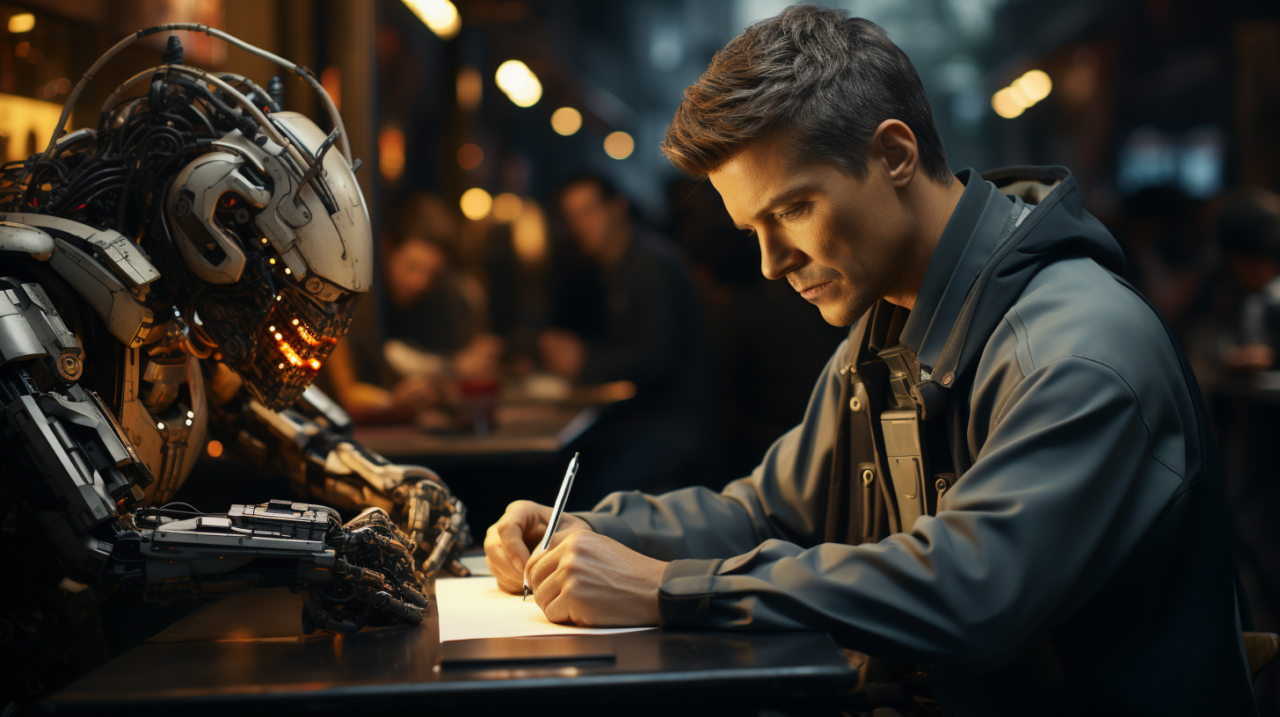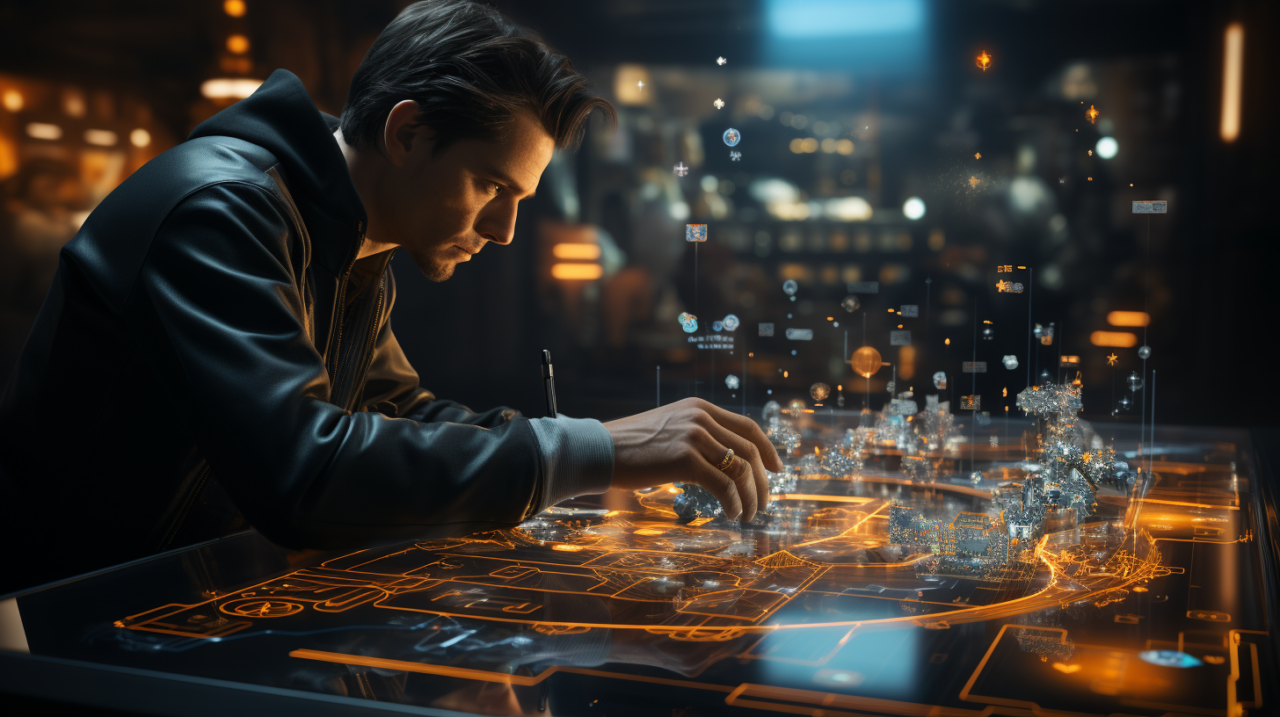L’intelligenza artificiale e l’automazione spinta da algoritmi stanno cambiando radicalmente il mondo del lavoro.
Il PROMPT dell’immagine, generata con MidJourney:
Cinematic shot. Visualize a scene that represents the radical changes in the world of work due to artificial intelligence and algorithm-driven automation. The content should be a split scene with one side showing a human worker performing repetitive tasks, and the other side showing an AI entity or robot performing the same tasks more efficiently. The medium should be photo hyper-realism, with a style that combines the organic aesthetics of human labor with the sleek, futuristic aesthetics of AI. The lighting should be contrasting, with warm light on the human side and cold light on the AI side. The colors should be a mix of warm earth tones for the human and cold metallic hues for the AI. The composition should be a centered shot, capturing both the human and the AI entity. –ar 16:9 –v 5.2 –style raw –q 2 –s 750
Se da un lato queste tecnologie stanno creando nuovi lavori legati proprio alla progettazione e gestione di sistemi basati su IA, dall’altro stanno anche sostituendo le persone in molti processi lavorativi ripetitivi e routinari.
Questa duplice dinamica avrà profonde implicazioni occupazionali nei prossimi decenni.
Da un lato, si prevede la creazione di nuovi lavori legati all’IA. Si parla già oggi di figure professionali come “data scientist”, “specialisti in intelligenza artificiale” e “esperti di machine learning”.
Il PROMPT dell’immagine, generata con MidJourney:
Cinematic shot. a scene that symbolizes a neoclassical/hi-tech Olympus, with managers represented as living gods using computers. A group of godlike managers should be in the foreground, their classical forms juxtaposed with the high-tech devices they are using. In the background, a sprawling cyberpunk city is filled with crowds of humans living in poverty and despair. The medium should be photo hyper-realism, with a style that evokes the stark, impersonal nature of a future dominated by advanced technology and the humanistic undertones of neoclassical art. The lighting should be stark and direct, emphasizing the manager with computers and the city. The colors should be a mix of stark whites for the statues, deep blacks, and vibrant neon hues for the city. The composition should be a centered shot of the gods, with the city stretching out behind them. Salvador Dali style –ar 16:9 –v 5.1 –style raw –q 2 –s 750
Tuttavia, queste nuove professioni richiedono competenze avanzate tipicamente appannaggio di una élite di lavoratori altamente qualificati.
Molti altri lavoratori, in particolare quelli impiegati in lavori routinari e ripetitivi, saranno invece in esubero, soppiantati dalla IA.
Già oggi l’intelligenza artificiale sta pilotando automi e robot industriali, sostituendo esseri umani in ambiti come l’agricoltura, la manifattura, il trasporto e la logistica.
Numerosi studi stimano che nei prossimi decenni decine di milioni di posti di lavoro, in particolare nei servizi, verranno persi a causa di queste tecnologie.
Alcuni esperti parlano di una “quarta rivoluzione industriale” trainata dall’automazione spinta dall’IA.
Il PROMPT dell’immagine, generata con MidJourney:
Cinematic shot. Visualize a scene that represents the radical changes in the world of work due to artificial intelligence and algorithm-driven automation. The content should be a split scene with one side showing a human worker performing repetitive tasks, and the other side showing an AI entity or robot performing the same tasks more efficiently. The medium should be photo hyper-realism, with a style that combines the organic aesthetics of human labor with the sleek, futuristic aesthetics of AI. The lighting should be contrasting, with warm light on the human side and cold light on the AI side. The colors should be a mix of warm earth tones for the human and cold metallic hues for the AI. The composition should be a centered shot, capturing both the human and the AI entity. Helmut Newton style –ar 16:9 –v 5.2 –style raw –q 2 –s 750
E’ difficile fare previsioni precise sugli effetti occupazionali di medio-lungo termine. Da un lato diversi lavori scompariranno, dall’altro se ne creeranno di nuovi in ambiti ancora difficilmente prevedibili.
Ad ogni modo, è chiaro che le competenze richieste ai lavoratori cambieranno radicalmente.
Saranno sempre meno richieste abilità manuali e cognitive routinarie, mentre sempre più importanti diverranno soft skill come la creatività, l’abilità nella risoluzione di problemi complessi, la flessibilità e la capacità di lavorare in team con la tecnologia.
Il PROMPT dell’immagine, generata con MidJourney:
Cinematic shot. Visualize a scene that represents the radical changes in the world of work due to artificial intelligence and algorithm-driven automation. The content should be a split scene with one side showing a human worker performing repetitive tasks, and the other side showing an AI entity or robot performing the same tasks more efficiently. The medium should be photo hyper-realism, with a style that combines the organic aesthetics of human labor with the sleek, futuristic aesthetics of AI. The lighting should be contrasting, with warm light on the human side and cold light on the AI side. The colors should be a mix of warm earth tones for the human and cold metallic hues for the AI. The composition should be a centered shot, capturing both the human and the AI entity. Salvador Dali style –ar 16:9 –v 5.2 –style raw –q 2 –s 750
L’impatto dell’intelligenza artificiale sul mondo del lavoro è complesso ma profondo, e richiede politiche attive del lavoro, formazione continua dei lavoratori e un ripensamento delle modalità di organizzazione della produzione.
La strada da percorrere è ancora lunga e irta di sfide, ma gli esperti concordano sul fatto che la collaborazione uomo-macchina, se ben gestita, può portare a un aumento della produttività e a nuove opportunità per tutti.





